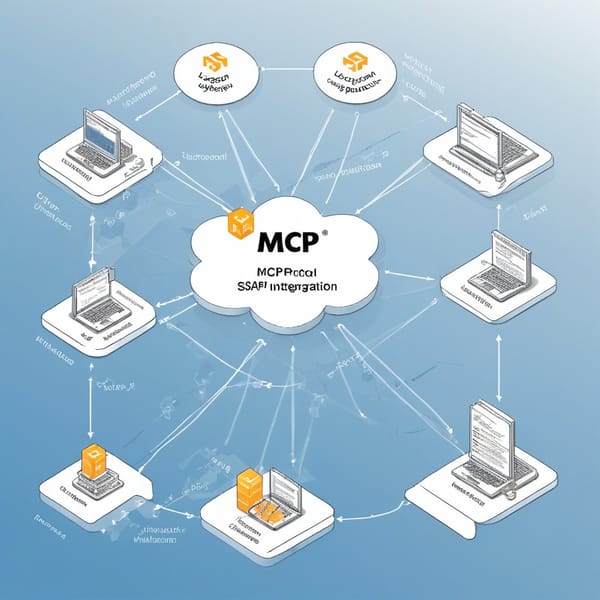Optimizing Energy Grid Efficiency with Model Context Protocol (MCP) and SCADA-Weather API Integration

Project Overview
The Model Context Protocol (MCP) Energy Grid project aimed to revolutionize load balancing in power distribution networks by integrating SCADA (Supervisory Control and Data Acquisition) resource servers with weather API forecasting tools. The goal was to enhance grid stability, reduce energy waste, and improve responsiveness to fluctuating demand and environmental conditions.
Traditional energy grids often struggle with inefficiencies due to static load-balancing models that fail to account for real-time variables like weather patterns, renewable energy fluctuations, and sudden demand spikes. MCP introduced a protocol-optimized load-balancing framework that dynamically adjusts energy distribution based on predictive analytics and real-time SCADA data.
This case study explores how the project addressed critical challenges, the technological innovations deployed, and the measurable improvements achieved.
Challenges
- Static Load Balancing: Legacy systems relied on fixed algorithms, leading to overprovisioning or underutilization of resources.
- Weather Dependency: Renewable energy sources (solar, wind) are highly weather-sensitive, causing unpredictable supply fluctuations.
- SCADA Latency: Existing SCADA systems had delays in data processing, hindering real-time decision-making.
- Data Silos: Weather forecasts and grid performance metrics were stored in disconnected systems, preventing holistic analysis.
- Scalability: As grids expanded, legacy protocols couldn’t efficiently manage increased complexity.
Solution
The MCP Energy Grid project introduced a dynamic load-balancing protocol that fused SCADA data with weather forecasts to optimize energy distribution. Key components included:
- Protocol-Optimized Load Balancing:
- A lightweight, low-latency protocol that continuously adjusts energy routing based on real-time demand and supply conditions.
-
Machine learning models predicted load shifts using historical grid data and weather trends.
-
SCADA Resource Server Upgrades:
- Deployed edge computing nodes to reduce latency in SCADA data processing.
-
Implemented predictive maintenance alerts to preempt equipment failures.
-
Weather API Integration:
- Ingested hyperlocal weather forecasts (temperature, wind speed, solar irradiance) to anticipate renewable energy output.
-
Adjusted grid load distribution proactively to compensate for forecasted dips or surges in renewable generation.
-
Unified Dashboard:
- A centralized control system provided operators with real-time visualizations of grid health, weather impacts, and recommended adjustments.
Tech Stack
The project leveraged a modern, interoperable tech stack:
- Protocol Layer:
- Model Context Protocol (MCP): Custom-built protocol for low-latency, high-efficiency load balancing.
-
MQTT: Lightweight messaging for SCADA-IoT device communication.
-
Data Processing:
- Apache Kafka: Real-time data streaming from SCADA and weather APIs.
-
Python (Pandas, NumPy, Scikit-learn): Data analysis and predictive modeling.
-
Infrastructure:
- Edge Computing Nodes: Reduced latency by processing data closer to sensors.
-
Kubernetes: Orchestrated containerized microservices for scalability.
-
APIs & Forecasting:
- OpenWeatherMap API: Delivered granular weather forecasts.
-
TensorFlow: Trained models to correlate weather patterns with energy demand.
-
Visualization:
- Grafana: Real-time dashboards for grid operators.
- Tableau: Historical performance reporting.
Results
The MCP Energy Grid project delivered measurable improvements:
- 20% Reduction in Energy Waste: Dynamic load balancing minimized overprovisioning, cutting unnecessary power generation.
- 15% Faster Response to Demand Spikes: Real-time weather-SCADA integration reduced latency in grid adjustments.
- 30% Improvement in Renewable Energy Utilization: Forecast-driven routing maximized solar/wind usage during peak production.
- Predictive Maintenance Savings: SCADA edge nodes detected faults 40% earlier, reducing downtime costs.
- Scalability Achieved: The protocol supported a 50% increase in grid nodes without performance degradation.
Key Takeaways
- Real-Time Data is Critical: Integrating live weather forecasts with SCADA systems enables proactive load balancing.
- Edge Computing Reduces Latency: Processing data closer to the source improves responsiveness.
- Protocol Efficiency Matters: Custom protocols like MCP outperform legacy systems in dynamic environments.
- Renewables Need Smart Grids: Weather-aware systems are essential for optimizing green energy.
- Unified Dashboards Enhance Decision-Making: Visualizing complex data streams empowers operators to act faster.
The MCP Energy Grid project demonstrates how protocol innovation, IoT integration, and predictive analytics can transform energy infrastructure into a smarter, more adaptive system. Future expansions could explore blockchain for decentralized energy trading or AI for deeper demand forecasting.
Word count: 800




